Blue and Back Striped Wing Blue and Black Striped Wing Bird
I sometimes use affiliate links in my content so if you choose to make a purchase, I earn a small commission at no extra cost to you.
Black-colored birds are one of the prettiest and most elegant in the world. Seeing one with distinctive white color on its wings in person can brighten your day.
Some consider them to be a bad omen though, while others think these dark birds signify intuition, mystery, and magic. Either way, their elegance and charm can't be denied.
In some black-colored birds, white wings are easy to spot even when the bird isn't moving; in others, it might take a bit more effort.
From the large Californian condor, white-winged chow, black vulture, to the medium-sized pied currawong, Australian magpie, to the smaller birds, such as lark bunting, white-winged tern, and white-winged robin, there's plenty of black birds with white wings.
Let's see what these birds look like and show you their photos and some fun facts.
Black Birds With White Wings
White-winged Chough

Scientific name: Corcorax melanorhamphos
Lifespan: 16 years
Wingspan: n/a
Plumage And Wing Color: Completely black with white wings
Found In: Australia
White-winged chough is a large, black bird the size of a crow that has a curved beak and deep red eyes. When the bird is in flight, the white color in the primary feathers of the wings (outer flight feathers) is easy to spot.
White-winged choughs are found in open forests and woodland in most of eastern and south-eastern mainland Australia.
These birds are famous for using leaf litter, soft grasses, and mud to construct their nests, which they build over several days.
White-winged choughs live in large flocks of up to 20 individuals – usually consisting of the breeding pair and their offspring. These birds are also known to kidnap young birds from other families to help with the communal raising of chicks.
They are not great at flying and can be mostly seen on the ground, looking for worms, insects, grain, termites, and snails.
Pied Currawong
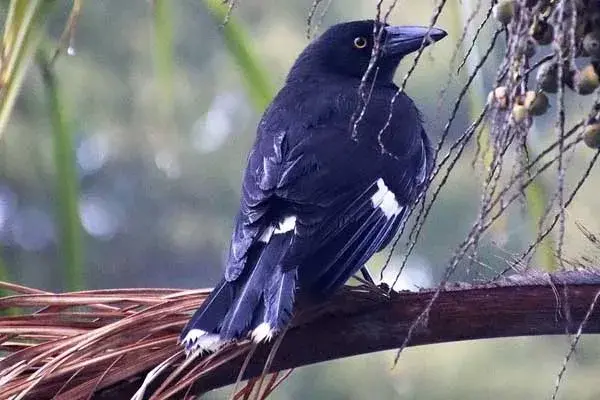
Scientific name: Strepera graculina
Lifespan: n/a
Wingspan: 22-30 in
Plumage And Wing Color: Black-colored with white on wings
Found in: Australia
The pied currawong is a medium-sized passerine bird with a large black bill and yellow eyes, native to eastern Australia and Lord Howe Island.
It is completely black with white color on the wings, undertail coverts, the base and the tip of the tail.
The pied currawong is an omnivorous and opportunistic feeder; it feeds on fruit, berries, and preys on small lizards, insects, and caterpillars.
These birds got their name from a call that sounds a bit like "curr-a-wong."
The female is responsible for building the nest high in the trees, producing a clutch of three pink-brown eggs.
White-winged Tern
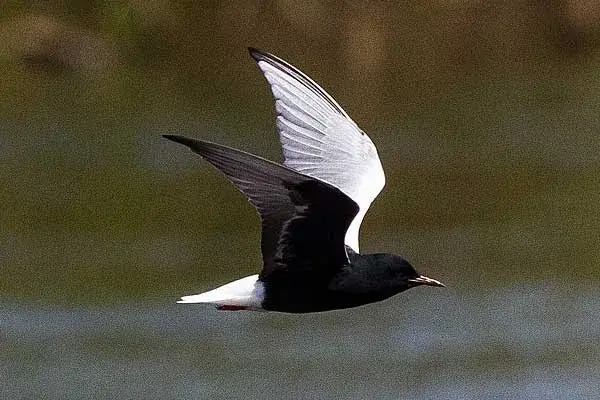
Scientific name: Chlidonias leucopterus
Lifespan: n/a
Wingspan: 23-26 in
Plumage And Wing Color: Mostly black and dark gray with white wings
Found In: Europe, Asia, Africa, and Australia
The white-winged tern, or white-winged black tern, is a small bird found near freshwaters across much of the world, including Europe, Africa, Asia, and Australia. Occasionally it might visit North America, parts of eastern Canada, and the U.S. east coast.
The white-winged tern has a mostly black body, white wings, and an almost completely-white tail and rump.
These terns are carnivores that mostly feed on insects and small fish, occasionally on some frogs. To get food, white-winged terns will not dive – they will fly slowly over the water to surface-pick items and catch insects in flight.
Lark Bunting
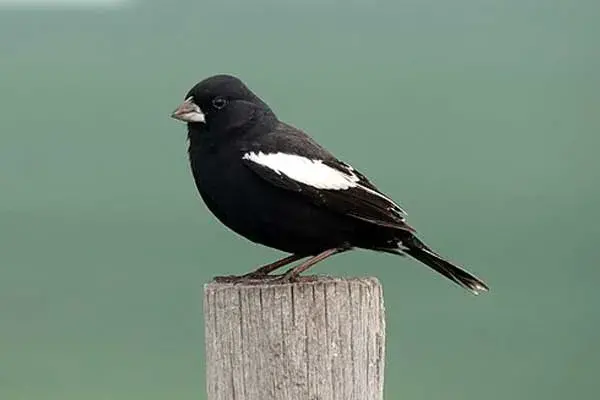
Scientific name: Calamospiza melanocorys
Lifespan: n/a
Wingspan: 10-11 in
Plumage And Wing Color: Black plumage with white color on the wings
Found In: North America
The lark bunting, a state bird of Colorado, is a medium-sized American sparrow found in grasslands of the central and western North America.
Breeding males are black with white wing patches. When the winter comes, they become grayish brown with small streaks of black and white. The beak has a pale blue-gray color.
The bird was selected as a state bird of Colorado due to its acrobatic courtship dance, melodic song, and being native there. Lark buntings hop along the ground when foraging; they walk or run when pursuing prey.
They are omnivores that feed on seeds, insects, and some fruits.
In case you decide to go searching for larks, make sure to bring good birdwatching equipment with you to spot and take good photos of these birds.
Black Vulture

Scientific name: Coragyps atratus
Lifespan: 10 years in the wild (up to 25 years)
Wingspan: 54-59 in
Plumage And Wing Color: Sooty black plumage with white stars under the wingtips
Found In: North, Central, and South America
The black vulture, also known as the American black vulture, is a large raptor. It has a sooty black plumage, a bare black head, and white wingtips. It can be found in forests and open areas of southeastern United States, Mexico, Central, and South America.
The black vulture is often mistaken for the turkey vulture – the black vulture is a bit smaller, has shorter wings and tail, and the wings have white wing patches (stars).
These birds are monogamous and pairs are believed to mate for life – both the male and female will take turns incubating their eggs.
Black vultures are very aggressive so other vulture species tend to avoid them.
They are carnivores that feed on carrion but may also hunt and eat small reptiles, birds, and mammals. To escape from danger, black vultures might regurgitate partially digested food, to become lighter before flying away.
Californian Condor
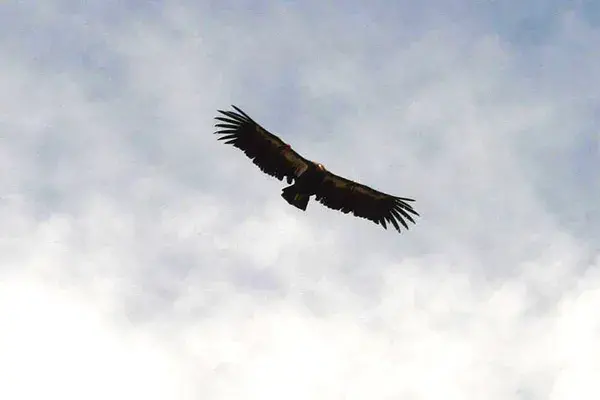
Scientific name: Gymnogyps californianus
Lifespan: up to 60 years
Wingspan: 114 in
Plumage And Wing Color: Black with striking white patches under the wings
Found In: North America
The California condor is the largest North American land bird and has a wingspan of over 9.5 feet.
In 1987, all of these birds in the wild were captured (all 27 of them). Since then, their population increased to over 500.
They have been slowly reintroduced in places like northern Arizona, southern Utah (including the Grand Canyon area and Zion National Park), the coastal mountains of central and southern California, and northern Baja California in Mexico.
Adult Californian condors are easy to recognize by the primarily black plumage, brilliant white triangle patches under each wing, and red or orange heads. This endangered vulture also has a bald head.
And like other vultures, Californian condors are scavengers that feed on the carcasses of large mammals. Because of their strong immune system, they do not get sick from the bacteria of the decaying animals.
Californian condors can reach top flying speeds of up to 56 miles per hour, gliding at altitudes of up to 15,000 feet. They are monogamous birds and mate for life.
White-winged Black-Tit

Scientific name: Parus leucomelas
Lifespan: n/a
Wingspan: n/a
Plumage And Wing Color: Black with white wings
Found In: Central Africa
First described in 1840, the white-winged black-tit is a small bird with black plumage, mostly white wings, and a white outer tail. Commonly found in moister types of savannas of central Africa, white-winged black-tits live in pairs or small groups.
These birds are very loud and conspicuous. White-winged black-tits look a lot like white-shouldered black-tits; the main difference is the dark, rather than yellow eyes.
Australian Magpie
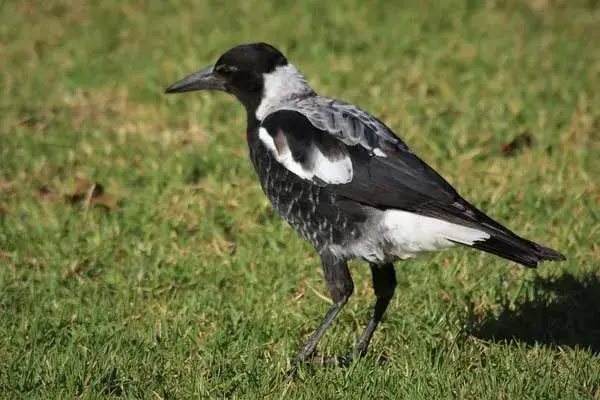
Scientific name: Gymnorhina tibicen
Lifespan: 25 years
Wingspan: 25-33 in
Plumage And Wing Color: Glossy, mostly black with white shoulder parts on the wings
Found In: Australia and southern New Guinea
The Australian magpie is a medium-sized black and white passerine bird found in grasslands, fields, residential areas, parks, and gardens of Australia and southern New Guinea.
It has a glossy black colored plumage with white-colored patches on its nape, upper tail, and shoulder parts of the wings.
Australian magpies are very smart diurnal birds that can recognize familiar people based on the sound of their voices. They can also mimic over 35 species of birds, as well as humans, dogs, and horses.
Australian magpies are omnivorous birds that feed on figs, grain, walnuts, earthworms, millipedes, snails, spiders, various insects, skinks, frogs, mice, and other small animals.
Eurasian Magpie
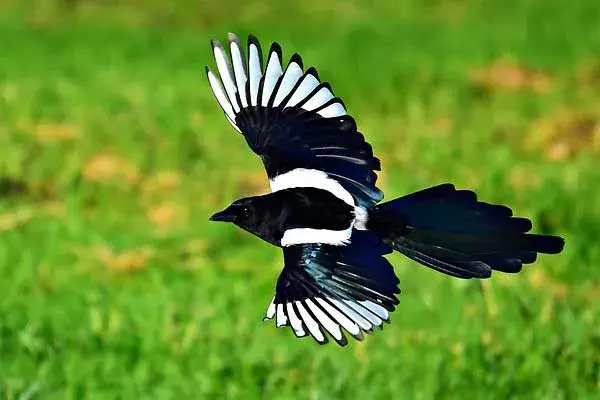
Scientific name: Pica pica
Lifespan: 2-3 years
Wingspan: 20-24 in
Plumage And Wing Color: Black with blue and green parts, and white patches on the wings
Found In: Europe, Asia, and northwest Africa
The Eurasian magpie, also known as the common magpie, is a resident breeding bird found throughout Europe, much of Asia, and Northwest Africa.
It is known for its black head, neck, and breast, green and violet sheen, and white streaks on the belly and scapulars (shoulder feathers).
The common magpie is one of the most intelligent birds – it can use tools, imitate human speech, grieve, play games, work in teams, and it will recognize itself in a reflection (the mirror test).
The only non-human species that have passed the mirror test are the great apes, dolphins, elephants, and magpies.
Eurasian magpies are omnivores that feed on young birds and eggs, small mammals, insects, carrion, acorns, and grain.
White-winged Robin

Scientific name: Peneothello sigillata
Lifespan: 2 years
Wingspan: n/a
Plumage And Wing Color: All black with visible white marks on the wings
Found In: New Guinea
White-winged Robin, a fairly small all-black bird with a black bill and feet, is found in subtropical or tropical moist montane forests of New Guinea.
Adults are easy to recognize by their black plumage and largely white wings – males and females look identical.
White-winged Robins are found in pairs or small groups. They are insectivorous, but will occasionally eat some seeds.
White-shouldered Tanager
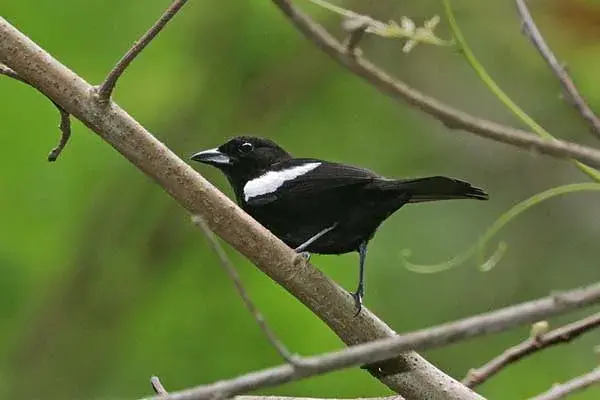
Scientific name: Tachyphonus luctuosus
Lifespan: n/a
Wingspan: n/a
Plumage And Wing Color: Glossy black with white underwing coverts and a conspicuous white shoulder patch
Found In: Central and South America
These medium-sized birds have striking sexual dimorphism: male White-shouldered tanagers are entirely black and have bold white shoulder patches while the females have gray heads, olive-green upperparts, and yellow underparts.
Mostly found in the humid forests of the lowlands and foothills of Central and South America, White-shouldered tanagers are omnivores that feed mainly on insects, but will occasionally eat some fruit.
They are social animals that are often found in pairs or small groups, usually with mixed feeding flocks.
Common Black Hawk

Scientific name: Buteogallus anthracinus
Lifespan: up to 13 years
Wingspan: 50 in
Plumage And Wing Color: Coal-black with a small white mark under the wings
Found In: North, Central, and South America
The common black hawk is a bird of prey and a member of the same family as the eagles, hawks, and Old World vultures. Almost always found near water; it would be a bit difficult to see them in the United States, as there are only 250 pairs found there.
Common black hawks arrive in the United States around March, stay over the summer, and depart in September and October.
Common black hawks are sexually dimorphic – the females are larger than the males. Both sexes exhibit the same coloration: they have a coal-black head, body, and wing coverts and white marks at the base of the outer two or three primaries on the parts of the underwings.
They are carnivores that feed on snakes, frogs, fish, young birds, eggs, and some crabs. Usually, they hunt together with their partner, flying together and stalking their prey from above.
Black Guillemot

Scientific name: Cepphus grylle
Lifespan: 11 years
Wingspan: 20-23 in
Plumage And Wing Color: Deep black with large white patches on the wings
Found In: Atlantic coast
The black guillemot or tystie is one of the prettiest and our favorite on the list of black birds with white wings.
It is a medium-sized seabird found in the coastal areas of the North Atlantic and Alaska.
The bill is black and the feet are bright red. Black guillemots are easy to recognize by their striking deep black plumage with white wings.
They sit on the water like ducks and will dive to catch prey near the bottom.
These birds breed in relatively small scattered colonies, lay 2 eggs, and stay monogamous for many nesting seasons.
Black guillemots feed on fish, crabs, shrimps, some mollusks, insects, marine worms, and bits of plant material.
White-winged Scoter

Scientific name: Melanitta deglandi
Lifespan: up to 18 years
Wingspan: 31-38 in
Plumage And Wing Color: Silken black plumage with large white patches on the wings (fully visible in flight)
Found In: North America
The white-winged scoter is a large sea duck and the largest scoter species. Males have a distinctive knob at the base of their beaks – their necks are thick and their heads have sloping foreheads.
Adult males also have silken black overall plumages with large white patches on the wings – this is clearly visible during flight, not so much when the bird is resting.
White-winged scoters can be found in freshwater lakes and wetlands in open country in the northwest interior of North America. A small number of them will winter on the eastern Great Lakes.
These birds are omnivores that feed mostly on mollusks, crustaceans, fish, insects, and some plants.
Ivory-billed Woodpecker

Scientific name: Campephilus principalis
Lifespan: n/a
Wingspan: 29-31.5 in
Plumage And Wing Color: Black with large white parts on the wings
Found In: USA and Cuba
The last widely accepted sighting of the Ivory-billed Woodpecker in North America was back in 1944. The third-largest woodpecker in the world and once common from the Carolinas to Texas nearly got declared extinct.
The species historically inhabited mature bottomland forests associated with river basins throughout the southeastern United States, with a small, separate population in Cuba.
A group of scientists climbing through Louisiana forests published a report (not peer-reviewed) claiming that they discovered the bird, taking several photos, videos, and audio recordings in the process.
These birds were mostly black with two white stripes down the neck and large white panels on the upper wings – males were with a red crest and the females with a black one.
Want to learn about birds living in Northeast Ohio? Check this fun article.
Anhinga
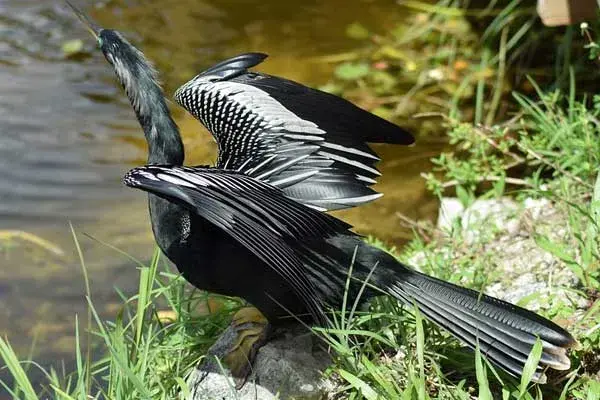
Scientific name: Anhinga anhinga
Lifespan: 12 years
Wingspan: 43 in
Plumage And Wing Color: Black with silvery-white parts on the wings
Found In: USA
The anhinga, also known as snakebird, darter, or water turkey, is a large and slender waterbird found in lakes, wooded swamps, marshes, and ponds.
The name anhinga comes from the Brazilian Tupi language and means "devil bird" or "snake bird".
Male anhingas are black with white spots on their wings; females look similar but have brownish necks and heads.
They do not have waterproof wings like other birds do and while swimming, only their necks appear above water, making them look like snakes.
Anhingas are carnivores that feed on fish, insects, shrimp, crayfish, and sometimes even young alligators and snakes.
White-winged Widowbird
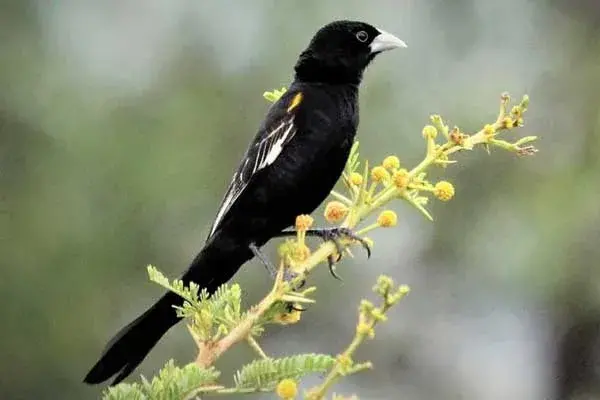
Scientific name: Euplectes albonotatus
Lifespan: n/a
Wingspan: n/a
Plumage And Wing Color: Black with white parts on wings in breeding males
Found In: Africa
The White-winged widowbird is polygynous, territorial, and solitary nesting bird. It is found in habitats like the savanna, grassland, wetland, as well as cultivated land.
These birds are highly sexually dimorphic during the breeding season – the male's yellow plumage turns dark and he gains more white feathers, especially on the wings.
White-winged widowbirds are omnivores that feed on grass seeds, nectar, and insects.
There are three subspecies of the white-winged widowbird.
Cuban Bullfinch
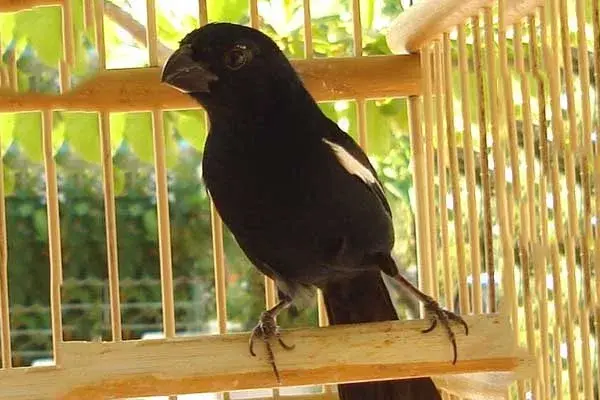
Scientific name: Melopyrrha nigra
Lifespan: n/a
Wingspan: n/a
Plumage And Wing Color: Glossy-black plumage with white wing patches on the shoulders and middle primaries
Found In: Cuba
The Cuban bullfinch is a small songbird found in the brushy and wooded habitats of Cuba. It is a possible vagrant visitor to the southern US states.
Male Cuban bullfinches are noted for having glossy black color and white wing patches, easy to see when the bird is resting or when flying. Females and young birds are duller, more charcoal, and less shiny; they also have a smaller white wing patch.
Cuban bullfinches are omnivores and feed on seeds, small fruits, flower nectar, and insects.
Black Swan

Scientific name: Cygnus atratus
Lifespan: up to 40 years
Wingspan: 62-79.2 in
Plumage And Wing Color: Completely black-feathered bird with white wing feathers
Found In: Australia, Europe, and North America
The black swan is a large waterbird that is native to Australia – it is found across the mainland, except for the Cape York Peninsula.
The bird is easily recognizable by its red bill, completely black plumage when swimming, and white wings with extensive bright flight feathers when flying.
Swans have far more neck bones than mammals – 24 or 25 vertebrae compared to only 7 of most mammals (giraffes also have 7 bones in their necks).
While breeding and nesting, black swans are known for crooning, making a soft singing and humming sound. They will also use only one leg while swimming, tucking the other above their tails.
Black swans are herbivores and feed on algae and weeds.
If you've enjoyed this article, make sure to check our article with 17+ examples of birds with yellow tails.
White-browed Wagtail
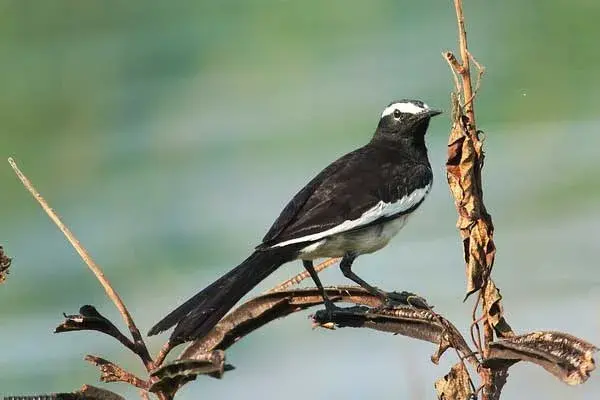
Scientific name: Motacilla maderaspatensis
Lifespan: 2 years
Wingspan: 12 in
Plumage And Wing Color: Black on top, white on the bottom with white edges on the wings
Found In: South Asia
The white-browed wagtail, also known as the large pied wagtail, is a medium-sized bird with prominent broad white eyebrows (supercilium).
It has a black head, back, upper tail, white wings edges, and white underparts.
The white-browed wagtail is a slender bird with a characteristically long and constantly-wagging tail, as the name suggests. It can be found in open freshwater wetland habitats.
Just like other wagtails, white-browed ones are insectivorous and feed on beetles, dragonflies, small snails, spiders, worms, crustaceans, and flies.
It got its scientific name from the Indian city of Madras (now Chennai). People used to keep white-browed tails as cage birds due to their amazing looks and singing abilities.
Read More: 20+ examples of amazing birds with eyebrows
Final Thoughts
If you happened to spot some bird with black plumage and the white color of its feathers, we hope this article helped you recognize it.
There are plenty of black birds with white wings, including the black guillemot, Colorado's state bird, the lark bunting, white-winged robin, and pied currawong, to name a few.
We hope you've enjoyed our list of 20+ black birds that have visible white wings in flight or when resting, and that next time, should you meet any of these in the wild, you will have no problem identifying the species you saw.
And if you want to learn more about birds, feel free to check our other popular reads: 20+ birds that have blue and white plumage and 20+ enormous black birds
Source: https://thedailywildlife.com/black-birds-with-white-wings/
0 Response to "Blue and Back Striped Wing Blue and Black Striped Wing Bird"
Postar um comentário